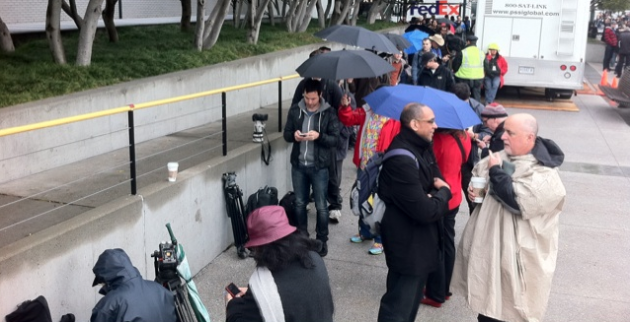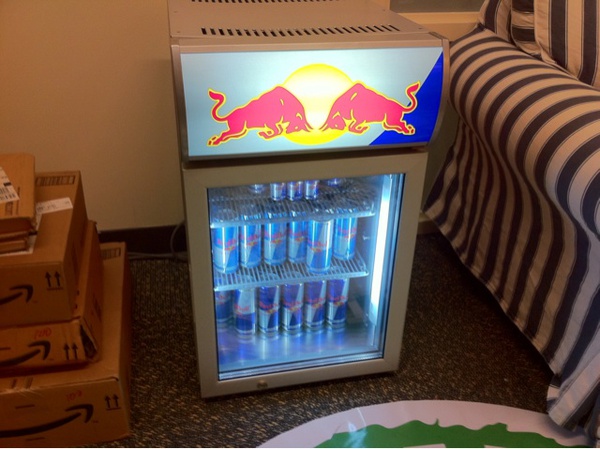
I hate liveblogging major events.
It’s hard. It’s painfully frustrating, and lifespan-limitingly stressful.
I also absolutely love it, and it’s one of my favorite parts of this job. It’s something that, from a technical stand point, was next to impossible to accomplish just years ago. It lets us transport our readers from their offices and living rooms to a spot right beside us in the packed auditorium, an experience that post-event recaps and standard news posts just can’t provide.
Our liveblog of Apple’s iPad 2 event on Wednesday went well; in fact, the response was probably the most unanimously positive one I’ve seen to anything I’ve ever done here. We’ve received thousands of e-mails, tweets, and comments about it, many of which asked how it all works and what it’s like to do. Rather than respond to each one individually, I’ve put together this post. It is, as best as I can convey, a look at things from the other side.
For those unfamiliar with the term: liveblogging (read: not life-blogging. That’s writing about what your cat had for breakfast) is covering a major event on the fly — in my case, usually product announcements. The person liveblogging acts as the eyes and ears for those at home, blasting out the details (be it text, images, video, or all of the above) through a system that automatically refreshes for the viewer the very instant new content is sent. Accurate immediacy is the goal.
At this point, I’ve probably liveblogged somewhere around 50 events. Some of them pulled in a few hundred readers; others manage to pull in many tens of thousands (It largely depends on the hype surrounding the product expected to be announced.) This post isn’t recapping Wednesday’s event, or any other specific event — it’s just a general, overarching look at how things work.
Blogsmas Eve:

The night before a big event is always sort of strange. Take the feeling you got as a kid on the night before Christmas — then take the feeling you get on the night before a big surgery. It’s something of a mix between the two. The gadget-geek in me is anxiously eager to see what new toys await; the battle-tested blogger in me dreads what might go wrong.
Like anything else in life, a successful liveblog is all about the prep work. The night before is for charging batteries (and back-up batteries!), clearing SD cards, brushing up on facts and tech specs, and doing dry runs of the liveblog system. There’s nothing quite like trying to log into the liveblog system 10 minutes before an event only to find that your password mysteriously no longer works, or that the whole thing is inexplicably broken. Anything that can go wrong will, so limiting the failure points is crucial.
With the battery and tool kit inventory checked and double checked, it’s off to bed. I usually start trying to conk out somewhere around 11, but end up running through things in my head (and trying to think of anything I may have forgotten to pack) until around 1 A.M. My brain finally chills out and lets things shut down when..
Get Up And Go:

BLARP! BLARP! BLARP! BLARP!
The alarm starts shrieking. After a night of narrowly dodging the REM cycle and avoiding anything resembling good sleep, smashing the snooze button a dozen times seems like a totally acceptable idea. The timing doesn’t exactly help; 9 times out of 10, we’re up long before the sun. If an event starts at 10AM., we’re up at 4 or 5. This is when the foundation generally starts being laid; we put up our “We’re live at Blah Blah Event!” posts, and connect the remaining dots in the backend (creating the liveblog embed, scheduling any countdown timers we might have, etc.). We’re usually out the door and on the way to the event about 2 hours before we think we need to be.
Why so early? Traffic. Traffic is the most avoidable wrench that can get thrown into the gears — but if you forget and it strikes, it’s nearly impossible to work around. Remember: these events are almost always held in the ultra-dense downtown areas of major cities, often at the worst possible commute times. The Traffic Gods don’t care that you’ve got an army of anxious geeks depending on you, and neither do the other people stuck in traffic.
The Pre-Game Show:

We’ve made it! We’re here! … Now what?
Every venue is different, and every company plans things differently. Figuring out where you’re supposed to be is often the first real test of the day. I covered a product announcement not too long ago at a venue that was spread out across around 40,000 square feet with 12 entrances, and there wasn’t a directional sign in sight. Fortunately, most venues tend to be considerably less ridiculous in their size and design, and things are usually a good bit more intuitive.
At most events, the staff will ask everyone to wait outside prior to check-in so that they can finish putting the last minute touches on everything inside, and ensure they’ve hidden anything that might ruin the surprise. Everyone stands in nice, straight little lines making casual conversation, politely watching each other’s bags (so that we can all get the ever-important shot of the line, like the one above) and inevitably defaulting to chit-chat about the weather.
About 40 minutes before the event starts, check-in begins. A nice friendly PR person from the company asks for your business card, scans for your name on the big list of approved attendees, hands you your badge, and points you in the right direction.
Then it all goes to hell.
Into The Mess:

Once badges are acquired, there’s generally a second indoor waiting area intended for people to mill about in before being let into the theater. There’s finger food and coffee (Remember: 5 a.m. wake up call, a race against traffic, then standing in line. Breakfast usually isn’t on the schedule, hence the very-much-appreciated food.) Unfortunately, few people can actually take the time to eat the food.
Remember those neat little lines from before? Sorry, bub — those are for when we’re outside. Once we’re badged, those finely organized queues turn into Black-Friday-esque blobs, with everyone trying to get just a little bit closer to the door. It’s especially bad when there’s only one or two doors into the auditorium; every time someone thinks the doors are opening and inches up, the entire back of the mass pushes forward. Things can get pretty claustrophobic. During my liveblog on Wednesday, the feeling of an impending trampling had me saying that I “felt like Mufasa” (a reference that my inner-child high-fived me for before he went back to crying over that scene.)
If we didn’t start posting to our liveblog when we were outside, this is when we’ll start. This is also when I’ll post our final “We’re live!” announcements.
We’re still on our feet at this point and the line-mob-thing rarely tends to form around any tables, so using a laptop gets a bit tricky. Some wiggle their way to the edge of the mob and camp out cross-legged on the floor. Those who are lucky enough to have an extra set of hands at the event may have whoever isn’t tasked with typing hold up the laptop (though this tends to make whoever is typing look like a total jerk). Others of us have developed a rather risky technique wherein we balance our laptop on one slightly bent leg and tell gravity to shove off by gripping the laptop in place with our wrists. Some liveblog backends are also smartphone-friendly, which makes this whole bit so, so much less painful (as long as the carriers haven’t already tanked). It also lets us shoot video and images when we otherwise just couldn’t.
After about a half dozen false alarms, the doors will eventually open. If laptops are still open, there’s about a 5 second window to get them packed up and secure before people get pushy.
The Battle:

Imagine 150 12 year old girls being let into a general admission Justin Bieber concert. Got that image in your head?
Okay, now replace the 12 year old girls with 6′ tall, 200 pound writers with backpacks and satchels in tow. Yeah.
It’s not quite so crazy at every event; a lot of it depends on the layout of the venue, and how important of an event it is. If the doors enter into the sides of the hall and the seats are nearby, it tends to be pretty calm. At other events, though…
Take WWDC, for example; this is where Apple annually announces their new iPhone — pretty much the biggest announcement of the year, from a readership standpoint. It’s also one of very few events that caters to both media and developers alike. You enter the massive WWDC theater from the back, and it’s a long, straight shot to row, after row, after row of seats. The first 5 feet from the door are usually taken at a brisk walk — then someone will slip into a jog, and the chain reaction has begun. By the 10 foot mark, the more intense folks are literally sprinting toward the front, backpack trailing behind them like a kite. It’s hilarious and absurd. (Especially when the dudes sprinting end up being the ones not taking photos, and spend the whole show jotting down notes on a pad of paper.)
Why the race for a seat? I mean, they sent out invites to this thing; obviously they’ve got room for everyone, right? Right. But unless you’ve lugged out your camera with an African-Safari-Mega-Lens on it, the closer you are, the better your photos will be. Add in the facts that seats are often reserved for executives and VIP guests/partners (a fact which is rarely clear before you’ve bolted up to a front row only to find a lil’ “RESERVED” sign on each seat), and that certain sections are often designated “No Photo Zones” so as to not blind (Flash-bang!) the people on stage, and the good ones start to fill up fast. Could the companies assign seats? Certainly! That is, they could if they didn’t mind people flipping out on them for giving other outlets seats that were arguably better in any way. Yeah, I’ve seen it happen.
The Event:

With the crowd conquered and a trampling avoided, the fun part is over. Seats are filled, the Black Eyed Peas soundtrack is blaring (I’ve heard “I’ve Got A Feelin’ (Tonight’s Gonna Be A Good Night)” somewhere around 87,000 times in the past year), and they’re asking everyone to silence their phones.
You attempt to hop on WiFi… and so does everyone else. The router bites the dust immediately (except at recent Apple events. I have no idea how they do it, but their network has been rock solid and mega fast for the last few shows. Others, like Samsung, have just taken to not providing WiFi at all.) You plug in one carrier’s 3G dongle, and the combination of a billionty cell phones and ultra-thick auditorium walls has it crawling at 3 kilobytes per second. You swap it out for another carrier’s — same deal. Readers start complaining about your silence, and your colleagues are texting to ask what’s up. Your pulse quickens; the liveblog viewer count was already at 5 digits before you even entered the theater, and they’re all expecting updates now. You try the last dongle in your bag —success! Now you’re just hoping that no else notices that Carrier X is the one with decent bandwidth.
The lights are dimmed, and the music fades. The CEO (or whoever is making the announcement) takes the stage. If there’s anything technical left that can go wrong, Murphy’s Law commands that it happen now.
At this point, the talents required of the liveblogger shift. Your ability to stare down would-be line cutters and resist the push of the crowd no longer matter — now it all boils down to your ability to multitask.
To be clear, “Multitasking” here takes on a whole new meaning. I’m not talking about being able to browse Reddit and hold an IM conversation at the same time. This is a one-man-band spectacle. You’re listening to every word that comes from the stage, with what you’re typing matching what’s being said with a delay of just a syllable or two. You’re taking pictures, pulling the SD card, slipping it into your computer, swapping your secondary card into the camera, and scanning for the best shot to upload. You’re blasting from browser tab to browser tab to verify specs of past models. All the while, you’re navigating through constant light changes that make your camera freak out, SD cards that SWEAR they haven’t been formatted even though you’ve been using them all day, and network connections that can go from 60 to 0 in the blink of an eye. And remember: Don’t. Miss. A. Word. (Oh, and don’t make typos.)
The best liveblogger is the one with 8 hands.
Speaking of extra hands: things can be made easier by having an extra person or two liveblogging with you — but that’s often just not possible. The more popular an event is, the more demand there is for seats, and the harder it is to get more than one seat for one outlet. Larger outlets occasionally have the pull to get an extra seat or two — but more often than not, it just doesn’t happen. And even if an extra seat can be had, the extra points of failure added by needing two solid WiFi connections, two fully charged batteries, and two people not missing a beat can just as easily make things harder.
There are technologies built to make these things simpler; MiFi portable hotspots, EyeFi cards that automatically post photos online, etc. Trust me — we use ’em all, when it’s feasible. Each one of them introduces a new point of failure into an already complicated orchestra of tools. In this game, the simplest formula tends to win.
Before you know it, the show is over. You don’t even remember looking at the stage.
Getting Handsy:

Take that 200+ person mob from before, and throw them in a room just outside of the auditorium with maybe 15 (usually fewer) of the devices that were just announced.
Some people just want to play with it. Others need to touch it for a few minutes, but have a day or two to write up their reports. For a smaller chunk of us, we’ve got 30-45 minutes to wiggle through the crowd, find a rep that hasn’t started their demonstration yet, record 4-5 minutes of video, take photos, use the device long enough to really get a feel for it, edit the video together, and get it online while dealing with the same connectivity issues as before.
Sound fun? No? Because it absolutely is. It feels like a bit of a game, even. Hell, thanks to other people jamming their cameras in your shot, there are even obstacles to avoid! The first to get a high quality video online wins.
The Post-Game Show:

The event is over. The hands-on post is up. You’re done, right?
Not quite. Now it’s time to talk!
Radio shows and TV outlets often don’t have the resources (be it invites, man-power, or need) to cover these events in-person, so they’ll often turn to those who were there to do the talking. By tomorrow, we’ll be back to talking about what meat Lady Gaga is wearing this week or the latest non-sense Charlie Sheen has babbled out, so it has to be today. Sure, your brain may be fried — but duty calls. Better Red Bull up, Brocahontas!
I’ve done interviews that I’m pretty sure I wasn’t actually awake for. Take this TCTV segment, for example — see my eyes? Yeah, they’re usually not half closed.
The End

Liveblogging is hard. It’s stressful. Done properly, it’ll destroy your mind and body for a day or two.
It’s also an absolute blast. Perhaps it’s some ultra-nerdy form of masochism, but I love it. Every second of it is a rush — and to be able to make a massive legion of gadget geeks happy (if only until the next time something goes wrong) makes every sweaty second and every panicked keystroke worth it. Thanks for reading our liveblogs, folks.
[Alarm photo by Michael Galpert on Flickr]